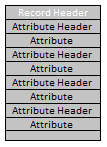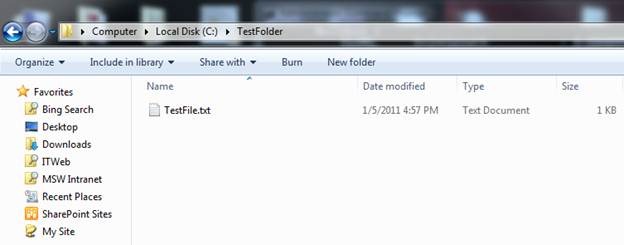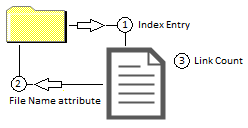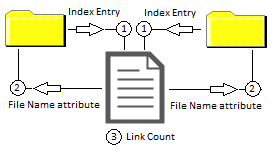How hard links work
I was asked in a prior comment to give greater detail on how hard linking works in the file system and how it applies to the component store and the way files are serviced. I’ve enlisted the assistance of my co-worker and uber disk expert Robert Mitchell to help describe this. I hope you all enjoy the material.
Hardlinks
First I would like to thank Joseph Conway for asking me to contribute to his blog.
The following information has been compiled to help you to better understand how hard links work in the context of using them with the component store. Hard links have been around for a while but it wasn’t until we started using them in the component store that they got much attention. They are used to allow us to have a file that exists in multiple directories without taking up extra space on the hard drive.
Before you start learning about hard links there are some basic file system concepts you must understand first.
· Master File Table
· File Record Segments
· File attributes
The Master File Table or MFT is a collection of 1k entries called File Record Segments or simply file records. A file record contains the metadata for a single file. Each file record has a number assigned to it that is used by NTFS to refer to the file.
For example, the first file created is called $MFT and is always file 0h. The root directory is file 5h. Special NTFS files, called metafiles, always use the same file record number. For a list of most of these metafiles and what they are used for please refer to https://blogs.technet.com/b/askcore/archive/2009/12/30/ntfs-metafiles.aspx.
File attributes are the building blocks of a file. Do not get these confused with attributes like READ-ONLY. Here is a simplified diagram of how a file record segment looks.
It starts out with a header. This has very basic information about the file, including something called a link count, which we will discuss later.
Each attribute has its own header that defines things about the attribute, like at what byte it starts at and its size.
The attribute itself provides metadata about the file. Common attribute types are $Standard_Information, $File_Name, and $Data. For a more complete list of file attributes, please refer to https://blogs.technet.com/b/askcore/archive/2010/08/25/ntfs-file-attributes.aspx.
When a file is created a relationship is forged between the new file and its parent directory. This relationship has three parts:
1. The parent directory has an index entry that refers to the file.
2. The file has a reference to its parent folder.
3. The file has a link count.
So let’s take this file and directory as an example. Here we see the directory TestFolder with a file called TestFile within.
Next we will use a tool to look at the directory’s file attributes using its file record number (4757h in this case). Such tools exist for download but not from Microsoft. We will NOT be discussing how they are used.
NOTE: Do not get caught up on the bulk of the metadata. We will be reviewing only what is important to the understanding hard links. Also in the spirit of simplification, I have removed any attributes that aren’t involved in any way with the demonstrating of how hard links function.
File Record 0x4757
_FILE_RECORD_SEGMENT_HEADER {
_MULTI_SECTOR_HEADER MultiSectorHeader {
ULONG Signature : 0x454c4946 "FILE"
USHORT SequenceArrayOffset : 0x0030
USHORT SequenceArraySize : 0x0003
}
LONGLONG Lsn : 0x00000005a660a744
USHORT SequenceNumber : 0x0025
USHORT ReferenceCount : 0x0001
USHORT FirstAttributeOffset : 0x0038
USHORT Flags : 0x0003
ULONG FirstFreeByte : 0x000001f8
ULONG BytesAvailable : 0x00000400
_MFT_SEGMENT_REFERENCE BaseFileRecordSegment {
ULONGLONG SegmentNumber : 0x0000000000000000
USHORT SequenceNumber : 0x0000
}
USHORT NextAttributeInstance : 0x0005
ULONG SegmentNumberLowPart : 0x00004757
USHORT SegmentNumberHighPart : 0x0000
}
_ATTRIBUTE_RECORD_HEADER { $STANDARD_INFORMATION:""
ULONG TypeCode : 0x00000010
ULONG RecordLength : 0x00000060
UCHAR FormCode : 0x00
UCHAR NameLength : 0x00
USHORT NameOffset : 0x0000
USHORT Flags : 0x0000
USHORT Instance : 0x0000
Resident {
ULONG ValueLength : 0x00000048
USHORT ValueOffset : 0x0018
UCHAR ResidentFlags : 0x00
UCHAR Reserved : 0x00
}
}
_STANDARD_INFORMATION {
LONGLONG CreationTime : 0x01cbad237cfab9d1 01/05/2011 LCL 16:57:04.245
LONGLONG LastModificationTime : 0x01cbad238c3239f8 01/05/2011 LCL 16:57:29.775
LONGLONG LastChangeTime : 0x01cbad238c808309 01/05/2011 LCL 16:57:30.288
LONGLONG LastAccessTime : 0x01cbad238c3239f8 01/05/2011 LCL 16:57:29.775
ULONG FileAttributes : 0x00000000
ULONG MaximumVersions : 0x00000000
ULONG VersionNumber : 0x00000000
ULONG ClassId : 0x00000000
ULONG OwnerId : 0x00000000
ULONG SecurityId : 0x00000539
ULONGLONG QuotaCharged : 0x0000000000000000
ULONGLONG Usn : 0x00000000f65da758
}
_ATTRIBUTE_RECORD_HEADER { $FILE_NAME:""
ULONG TypeCode : 0x00000030
ULONG RecordLength : 0x00000070
UCHAR FormCode : 0x00
UCHAR NameLength : 0x00
USHORT NameOffset : 0x0000
USHORT Flags : 0x0000
USHORT Instance : 0x0003
Resident {
ULONG ValueLength : 0x00000056
USHORT ValueOffset : 0x0018
UCHAR ResidentFlags : 0x01
UCHAR Reserved : 0x00
}
}
_FILE_NAME {
_MFT_SEGMENT_REFERENCE ParentDirectory {
ULONGLONG SegmentNumber : 0x0000000000000005
USHORT SequenceNumber : 0x0005
}
_DUPLICATED_INFORMATION Info {
LONGLONG CreationTime : 0x01cbad237cfab9d1 01/05/2011 LCL 16:57:04.245
LONGLONG LastModificationTime : 0x01cbad237cfab9d1 01/05/2011 LCL 16:57:04.245
LONGLONG LastChangeTime : 0x01cbad237cfab9d1 01/05/2011 LCL 16:57:04.245
LONGLONG LastAccessTime : 0x01cbad237cfab9d1 01/05/2011 LCL 16:57:04.245
LONGLONG AllocatedLength : 0x0000000000000000
LONGLONG FileSize : 0x0000000000000000
ULONG FileAttributes : 0x10000000
PackedEaSize : 0x0000
ULONG ReparsePointTag : 0x00000000
}
UCHAR FileNameLength : 0x0a
UCHAR Flags : 0x00
..... FileName : "TestFolder"
}
<Attribute removed from display for simplification>
_ATTRIBUTE_RECORD_HEADER { $INDEX_ROOT:"$I30"
ULONG TypeCode : 0x00000090
ULONG RecordLength : 0x000000c0
UCHAR FormCode : 0x00
UCHAR NameLength : 0x04
USHORT NameOffset : 0x0018
USHORT Flags : 0x0000
USHORT Instance : 0x0001
Resident {
ULONG ValueLength : 0x000000a0
USHORT ValueOffset : 0x0020
UCHAR ResidentFlags : 0x00
UCHAR Reserved : 0x00
}
}
_INDEX_ROOT {
ULONG IndexedAttributeType : 0x00000030
ULONG CollationRule : 0x00000001
ULONG BytesPerIndexBuffer : 0x00001000
_INDEX_HEADER {
ULONG FirstIndexEntry : 0x00000010
ULONG FirstFreeByte : 0x00000090
ULONG BytesAvailable : 0x00000090
UCHAR Flags : 0x00
..... Reserved :
}
}
_INDEX_ENTRY {
_MFT_SEGMENT_REFERENCE FileReference {
ULONGLONG SegmentNumber : 0x00000000000054f7
USHORT SequenceNumber : 0x0567
}
USHORT Length : 0x0070
USHORT AttributeLength : 0x005a
USHORT Flags : 0x0000
..... Reserved :
_FILE_NAME {
_MFT_SEGMENT_REFERENCE ParentDirectory {
ULONGLONG SegmentNumber : 0x0000000000004757
USHORT SequenceNumber : 0x0025
}
_DUPLICATED_INFORMATION Info {
LONGLONG CreationTime : 0x01cbad2389b8ec62 01/05/2011 LCL 16:57:25.624
LONGLONG LastModificationTime : 0x01cbad2392dec574 01/05/2011 LCL 16:57:40.972
LONGLONG LastChangeTime : 0x01cbad2392dec574 01/05/2011 LCL 16:57:40.972
LONGLONG LastAccessTime : 0x01cbad2389b8ec62 01/05/2011 LCL 16:57:25.624
LONGLONG AllocatedLength : 0x0000000000000008
LONGLONG FileSize : 0x0000000000000008
ULONG FileAttributes : 0x00000020
PackedEaSize : 0x0000
ULONG ReparsePointTag : 0x00000000
}
UCHAR FileNameLength : 0x0c
UCHAR Flags : 0x00
..... FileName : "TestFile.txt"
}
}
The section marked in RED is the index entry for the one file that is housed by this directory, TestFile.txt. If the directory had multiple files, then there would be additional index entries.
Inside the index entry you can see a segment number…
ULONGLONG SegmentNumber : 0x00000000000054f7
This segment number is the file record number for example file. Also listed in the index entry is the name of the file.
..... FileName : "TestFile.txt"
What this tells us is that this directory has a file named ‘TestFile.txt’ and it can be found at file record number 54f7h in the MFT.
Looking at the file itself…
File Record 0x54f7
_FILE_RECORD_SEGMENT_HEADER {
_MULTI_SECTOR_HEADER MultiSectorHeader {
ULONG Signature : 0x454c4946 "FILE"
USHORT SequenceArrayOffset : 0x0030
USHORT SequenceArraySize : 0x0003
}
LONGLONG Lsn : 0x00000005a660c4e6
USHORT SequenceNumber : 0x0567
USHORT ReferenceCount : 0x0001
USHORT FirstAttributeOffset : 0x0038
USHORT Flags : 0x0001
ULONG FirstFreeByte : 0x00000160
ULONG BytesAvailable : 0x00000400
_MFT_SEGMENT_REFERENCE BaseFileRecordSegment {
ULONGLONG SegmentNumber : 0x0000000000000000
USHORT SequenceNumber : 0x0000
}
USHORT NextAttributeInstance : 0x0005
ULONG SegmentNumberLowPart : 0x000054f7
USHORT SegmentNumberHighPart : 0x0000
}
_ATTRIBUTE_RECORD_HEADER { $STANDARD_INFORMATION:""
ULONG TypeCode : 0x00000010
ULONG RecordLength : 0x00000060
UCHAR FormCode : 0x00
UCHAR NameLength : 0x00
USHORT NameOffset : 0x0000
USHORT Flags : 0x0000
USHORT Instance : 0x0000
Resident {
ULONG ValueLength : 0x00000048
USHORT ValueOffset : 0x0018
UCHAR ResidentFlags : 0x00
UCHAR Reserved : 0x00
}
}
_STANDARD_INFORMATION {
LONGLONG CreationTime : 0x01cbad2389b8ec62 01/05/2011 LCL 16:57:25.624
LONGLONG LastModificationTime : 0x01cbad2392dec574 01/05/2011 LCL 16:57:40.972
LONGLONG LastChangeTime : 0x01cbad2392dec574 01/05/2011 LCL 16:57:40.972
LONGLONG LastAccessTime : 0x01cbad2389b8ec62 01/05/2011 LCL 16:57:25.624
ULONG FileAttributes : 0x00000020
ULONG MaximumVersions : 0x00000000
ULONG VersionNumber : 0x00000000
ULONG ClassId : 0x00000000
ULONG OwnerId : 0x00000000
ULONG SecurityId : 0x00000538
ULONGLONG QuotaCharged : 0x0000000000000000
ULONGLONG Usn : 0x00000000f65db1a8
}
_ATTRIBUTE_RECORD_HEADER { $FILE_NAME:""
ULONG TypeCode : 0x00000030
ULONG RecordLength : 0x00000078
UCHAR FormCode : 0x00
UCHAR NameLength : 0x00
USHORT NameOffset : 0x0000
USHORT Flags : 0x0000
USHORT Instance : 0x0003
Resident {
ULONG ValueLength : 0x0000005a
USHORT ValueOffset : 0x0018
UCHAR ResidentFlags : 0x01
UCHAR Reserved : 0x00
}
}
_FILE_NAME {
_MFT_SEGMENT_REFERENCE ParentDirectory {
ULONGLONG SegmentNumber : 0x0000000000004757
USHORT SequenceNumber : 0x0025
}
_DUPLICATED_INFORMATION Info {
LONGLONG CreationTime : 0x01cbad2389b8ec62 01/05/2011 LCL 16:57:25.624
LONGLONG LastModificationTime : 0x01cbad2389b8ec62 01/05/2011 LCL 16:57:25.624
LONGLONG LastChangeTime : 0x01cbad2389b8ec62 01/05/2011 LCL 16:57:25.624
LONGLONG LastAccessTime : 0x01cbad2389b8ec62 01/05/2011 LCL 16:57:25.624
LONGLONG AllocatedLength : 0x0000000000000000
LONGLONG FileSize : 0x0000000000000000
ULONG FileAttributes : 0x00000020
PackedEaSize : 0x0000
ULONG ReparsePointTag : 0x00000000
}
UCHAR FileNameLength : 0x0c
UCHAR Flags : 0x00
..... FileName : "TestFile.txt"
}
<Attribute removed from display for simplification>
_FILE_OBJECTID_BUFFER {
GUID BirthVolumeId {00000000-0000-0000-0000000000000000}
GUID BirthObjectId {00000000-0000-0000-0000000000000000}
GUID DomainId {00000000-0000-0000-0000000000000000}
GUID ObjectId {0df3b845-0e3c-11e0-b14e001f2901477c}
CHAR ExtendedInfo[] {
...
}
}
_ATTRIBUTE_RECORD_HEADER { $DATA:""
ULONG TypeCode : 0x00000080
ULONG RecordLength : 0x00000020
UCHAR FormCode : 0x00
UCHAR NameLength : 0x00
USHORT NameOffset : 0x0018
USHORT Flags : 0x0000
USHORT Instance : 0x0001
Resident {
ULONG ValueLength : 0x00000008
USHORT ValueOffset : 0x0018
UCHAR ResidentFlags : 0x00
UCHAR Reserved : 0x00
}
}
<Attribute removed from display for simplification>
The parts marked in RED are the reference count aka link count and the file name attribute. The link count tells us how many times a directory links back to this file. Since our link count is 1, we know that this file can only be found in a single directory.
The file name attribute is where we keep track of who the parent directory is. Looking closer at the attribute, we can see the following line…
ULONGLONG SegmentNumber : 0x0000000000004757
This tells us that the file has a parent directory that can be found at file record number 4757h.
So the three parts to the file/directory relationship are now visible. Here is a simplified diagram of this relationship…
1. The directory has an index entry that tells us the file record number for the child file.
2. The file has a file name attribute that tells us what the file record number of the parent directory.
3. The file has a link count that tells us that it only has one parent directory.
Once you understand this, adding in a hard link is a fairly simple matter.
We still use basically the same diagram but now we have two directories, each with its own relationship with the file.
1. Each directory has an index entry that tells us the file record number for the child file.
2. The file has two file name attributes. One for each parent directory.
3. The link count is incremented to 2h.
This is how the component store functions. All operating system files are placed into organized subdirectories under the WinSXS directory. When a role is added, we simply create a new links to the appropriate files, usually linking them to the System32 or SysWOW64 directories.
Here is a such a file.
File Record 0x94df
_FILE_RECORD_SEGMENT_HEADER {
_MULTI_SECTOR_HEADER MultiSectorHeader {
ULONG Signature : 0x454c4946 "FILE"
USHORT SequenceArrayOffset : 0x0030
USHORT SequenceArraySize : 0x0003
}
LONGLONG Lsn : 0x000000057b08b20d
USHORT SequenceNumber : 0x0001
USHORT ReferenceCount : 0x0002
USHORT FirstAttributeOffset : 0x0038
USHORT Flags : 0x0001
ULONG FirstFreeByte : 0x000001d8
ULONG BytesAvailable : 0x00000400
_MFT_SEGMENT_REFERENCE BaseFileRecordSegment {
ULONGLONG SegmentNumber : 0x0000000000000000
USHORT SequenceNumber : 0x0000
}
USHORT NextAttributeInstance : 0x0005
ULONG SegmentNumberLowPart : 0x000094df
USHORT SegmentNumberHighPart : 0x0000
}
_ATTRIBUTE_RECORD_HEADER { $STANDARD_INFORMATION:""
ULONG TypeCode : 0x00000010
ULONG RecordLength : 0x00000060
UCHAR FormCode : 0x00
UCHAR NameLength : 0x00
USHORT NameOffset : 0x0000
USHORT Flags : 0x0000
USHORT Instance : 0x0000
Resident {
ULONG ValueLength : 0x00000048
USHORT ValueOffset : 0x0018
UCHAR ResidentFlags : 0x00
UCHAR Reserved : 0x00
}
}
_STANDARD_INFORMATION {
LONGLONG CreationTime : 0x01ca04156a9a588b 07/13/2009 LCL 19:55:36.280
LONGLONG LastModificationTime : 0x01ca042443976710 07/13/2009 LCL 21:41:53.281
LONGLONG LastChangeTime : 0x01caee3b49efdbbe 05/07/2010 LCL 19:16:14.441
LONGLONG LastAccessTime : 0x01ca04156a9a588b 07/13/2009 LCL 19:55:36.280
ULONG FileAttributes : 0x00000020
ULONG MaximumVersions : 0x00000000
ULONG VersionNumber : 0x00000000
ULONG ClassId : 0x00000000
ULONG OwnerId : 0x00000000
ULONG SecurityId : 0x000001f7
ULONGLONG QuotaCharged : 0x0000000000000000
ULONGLONG Usn : 0x0000000001843698
}
_ATTRIBUTE_RECORD_HEADER { $FILE_NAME:""
ULONG TypeCode : 0x00000030
ULONG RecordLength : 0x00000078
UCHAR FormCode : 0x00
UCHAR NameLength : 0x00
USHORT NameOffset : 0x0000
USHORT Flags : 0x0000
USHORT Instance : 0x0002
Resident {
ULONG ValueLength : 0x0000005a
USHORT ValueOffset : 0x0018
UCHAR ResidentFlags : 0x01
UCHAR Reserved : 0x00
}
}
_FILE_NAME {
_MFT_SEGMENT_REFERENCE ParentDirectory {
ULONGLONG SegmentNumber : 0x0000000000001709
USHORT SequenceNumber : 0x0001
}
_DUPLICATED_INFORMATION Info {
LONGLONG CreationTime : 0x01caee3b3b1feba9 05/07/2010 LCL 19:15:49.590
LONGLONG LastModificationTime : 0x01caee3b3b1feba9 05/07/2010 LCL 19:15:49.590
LONGLONG LastChangeTime : 0x01caee3b3b1feba9 05/07/2010 LCL 19:15:49.590
LONGLONG LastAccessTime : 0x01caee3b3b1feba9 05/07/2010 LCL 19:15:49.590
LONGLONG AllocatedLength : 0x0000000000000000
LONGLONG FileSize : 0x0000000000000000
ULONG FileAttributes : 0x00000020
PackedEaSize : 0x0000
ULONG ReparsePointTag : 0x00000000
}
UCHAR FileNameLength : 0x0c
UCHAR Flags : 0x00
..... FileName : "OobeFldr.dll"
}
_ATTRIBUTE_RECORD_HEADER { $FILE_NAME:""
ULONG TypeCode : 0x00000030
ULONG RecordLength : 0x00000078
UCHAR FormCode : 0x00
UCHAR NameLength : 0x00
USHORT NameOffset : 0x0000
USHORT Flags : 0x0000
USHORT Instance : 0x0004
Resident {
ULONG ValueLength : 0x0000005a
USHORT ValueOffset : 0x0018
UCHAR ResidentFlags : 0x01
UCHAR Reserved : 0x00
}
}
_FILE_NAME {
_MFT_SEGMENT_REFERENCE ParentDirectory {
ULONGLONG SegmentNumber : 0x00000000000010f4
USHORT SequenceNumber : 0x0001
}
_DUPLICATED_INFORMATION Info {
LONGLONG CreationTime : 0x01caee3b3b1feba9 05/07/2010 LCL 19:15:49.590
LONGLONG LastModificationTime : 0x01caee3b3b1feba9 05/07/2010 LCL 19:15:49.590
LONGLONG LastChangeTime : 0x01caee3b3b1feba9 05/07/2010 LCL 19:15:49.590
LONGLONG LastAccessTime : 0x01caee3b3b1feba9 05/07/2010 LCL 19:15:49.590
LONGLONG AllocatedLength : 0x00000000000dc000
LONGLONG FileSize : 0x00000000000db600
ULONG FileAttributes : 0x00000020
PackedEaSize : 0x0000
ULONG ReparsePointTag : 0x00000000
}
UCHAR FileNameLength : 0x0c
UCHAR Flags : 0x00
..... FileName : "OobeFldr.dll"
}
_ATTRIBUTE_RECORD_HEADER { $DATA:""
ULONG TypeCode : 0x00000080
ULONG RecordLength : 0x00000048
UCHAR FormCode : 0x01
UCHAR NameLength : 0x00
USHORT NameOffset : 0x0000
USHORT Flags : 0x0000
USHORT Instance : 0x0003
Nonresident {
LONGLONG LowestVcn : 0x0000000000000000
LONGLONG HighestVcn : 0x00000000000000db
USHORT MappingPairsOffset : 0x0040
UCHAR CompressionUnit : 0x00
..... Reserved :
LONGLONG AllocatedLength : 0x00000000000dc000
LONGLONG FileSize : 0x00000000000db600
LONGLONG ValidDataLength : 0x00000000000db600
}
<Attribute removed from display for simplification>
The link count has been set to 2h.
USHORT ReferenceCount : 0x0002
This tells us that there are two directory relationships to this file.
Also notice that this file has two file name attributes. If you compare the file record number for each attribute, you can see that they differ.
ULONGLONG SegmentNumber : 0x0000000000001709
ULONGLONG SegmentNumber : 0x00000000000010f4
Each file record number points to one of the parent directories of this file. This is how a single file can exist in multiple directories.
That is the nature of how hard links work.
As a final note, this is completely different than how a reparse point functions. But that is a subject for another time.
Thank you for your time.
Robert Mitchell
Microsoft Enterprise Support - Windows Server CoreTeam
Want to know more about Microsoft storage? Check out my other blogs...
https://blogs.technet.com/askcore/archive/2009/10/16/the-four-stages-of-ntfs-file-growth.aspx
https://blogs.technet.com/askcore/archive/2009/12/30/ntfs-metafiles.aspx
https://blogs.technet.com/b/askcore/archive/2010/08/25/ntfs-file-attributes.aspx
https://blogs.technet.com/b/askcore/archive/2010/10/08/gpt-in-windows.aspx
NEW NEW NEW!!
https://blogs.technet.com/b/askperf/archive/2010/12/03/performance-counter-for-iscsi.aspx
Comments
Anonymous
January 01, 2003
@Ikraav; RIght now nothing is very accurate when it comes to the actual size reporting of the directory. I've had talks around a better tool internally so we'll see what comes out of it. As for your question about copying extra data to the drive, the answer is no. Once explorer see's the disk as full, its full.Anonymous
January 01, 2003
Dean; I haven forgotten about it but the release of SP1 has me pretty busy atm. I'll see what I can do in regards to a better image for you and post something as soon as I have it. --JosephAnonymous
January 01, 2003
The comment has been removedAnonymous
January 01, 2003
The comment has been removedAnonymous
January 01, 2003
The comment has been removedAnonymous
January 01, 2003
@Ikraav; Hard links provide the ability to update a file in multiple locations by using just one instance of a file, it's a common file system efficiency model. It wasnt used to get the OS "out the door" at all. From a servicing perspective, it actually provides a very useful function and that's during repair operations. Just the other day we had a customer that had a server down because of some unknown software installation failure. It turned out that the software they were installing was trying to forcefully attempt to overwrite a system binary and was partly successful. Because of hardlinking, we were able to run SFC against the file and get the machine back up in a couple of seconds.Anonymous
January 01, 2003
The comment has been removedAnonymous
January 01, 2003
I did do a part 2 for this. Here's a link to the second posting. blogs.technet.com/.../more-on-hard-links.aspxAnonymous
January 01, 2003
Dean; I'll see what I can do, a chart like that might be a little more time than I have right now (just setting expectations on what I can do here) --JosephAnonymous
January 09, 2011
Thanks soooo much for doing this ! I almost forgot I asked for the information. Now as good as this information is, it STILL doesn't answer the fundamental question. You guys keep saying that when a file ( hard link ) in one of the non WinSXS directories gets 'corrupted' or 'serviced' it gets replaced by a 'fresh' or 'updated' version from the WinSXS directory like when you run the System File Checker or install a service pack. If the 'file' is nothing but an index entry, is it the index entry that gets corrupted and replaced ? What is the SFC really checking ? What is being fixed and replaced by the servicing stack ?Anonymous
January 10, 2011
Please provide a Microsoft tool to view the true and accurate size of the WinSxS directory on Windows 7 and Vista. Only a tool that lets us view the actual size will appease us. Steven Sinofsky said on the E7 blog that the size is close to 400 MB on a fresh install but I refuse to believe that. So far I only know of this tool called cttruesize (www.heise.de/.../50272) and it shows several GBs even if it subtracts all types of junction points and hard links.Anonymous
January 11, 2011
The comment has been removedAnonymous
January 15, 2011
Joseph, No. I think I get your example though but only because we are dealing with a real file that we manually put there. But that's like the old days. It doesn't explain what really happens with a "projected" file. I can't be the only dummy out here who doesn't get this but needs and wants to. I firmly beleive that what is needed is a nice article that combines the above technical file details with diagrams with arrows and such that shows exactly what happens when different examples occur. This article should then be made into a KB article and posted on Technet so that everyone can find it.Anonymous
January 17, 2011
Joseph, Even if I had to wait a month or two it would be worth the wait.Anonymous
February 12, 2011
Joseph, Any chance that you will be able to do the better document ?Anonymous
April 01, 2011
Hi joscon, thanks a lot for your writings on the subject. (W7 SP1) With regards to WinSxS, hard links and Windows Explorer not being able to calculate this folder's real size correctly, I'm wondering where am I supposed to get my accurate Drive Free Space reading from? If Explorer can't account for hard links, can any other built-in Windows tool (Disk Mgmt, anything else)? Or does this mean that drive free space is constantly reported incorrectly? What happens if Explorer thinks WinSxS occupies 15G, when physically it occupies only 1G, and I fill the disk up? Will I be able to copy 14G more files on the drive with the free space indicator staying at zero all the time?Anonymous
April 03, 2011
@joscon: thanks a lot for clarification. so in other words while hard links as a concept is designed for space efficiency, in this windows vista+ ecosystem implementation all the hard links might as well be actual space occupying files, since the the space is unusable for the user anyway. is there anything the user wins out of this hard links winsxs implementation vs regular files? was this implementation acceptable because the initial product needed to get out the door and making the hard linked saved space actually available for use could be addressed with some patch in a later service pack (obviously not in W7SP1..)?Anonymous
April 21, 2011
@joscon Hi and thanks for your responses. Does this mean that Explorer is reporting correctly the disk is full when much of the drive space is only being used by hard links? This makes no sense to me. What is the point of a hard link versus just saving multiple copies of the actual files. There's no efficiency in the model Microsoft chose whatsoever if I understand you correctly. I'm trying to combat my disks constantly filling up sending me Nagios alerts and using up very costly SAN space. Please advise as I am constantly battling Windows 2008 filling up the C drive with WinSXS and other hard linked files.Anonymous
June 07, 2011
Joseph, Is there any chance that you will be able to do the better document yet ?



